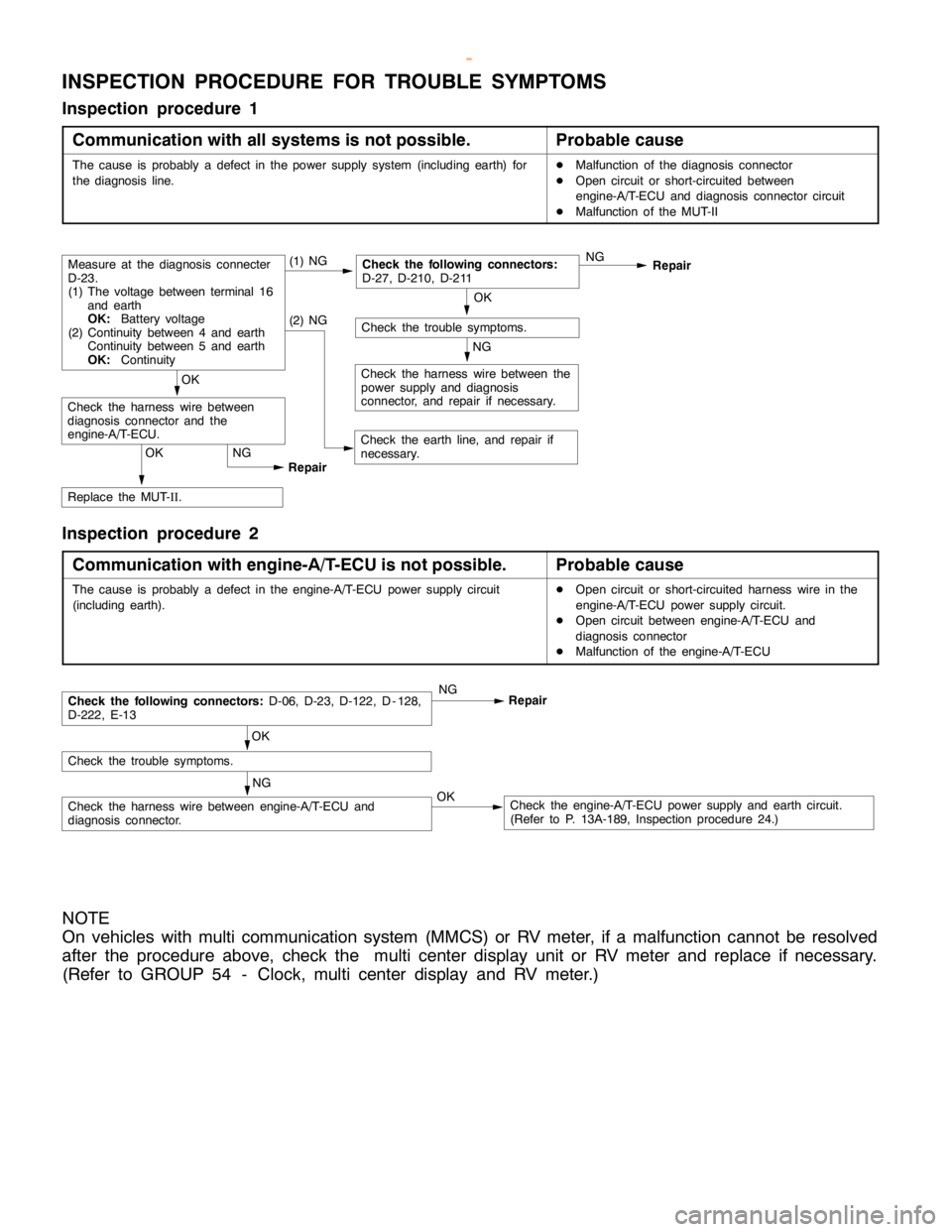2000 MITSUBISHI MONTERO lock
[x] Cancel search: lockPage 36 of 1839

GENERAL -Supplemental Restraint System (SRS)00-35
SRS-ECU
Terminal No.Destination of harnessCorrective action
1, 2, 3, 4Instrument panel wiring harness®Front wiring harness®Front
impact sensorRepair or replace each wiring
harness
7Instrument panel wiring harness®EarthRepair or replace Instrument
8Instrument panel wiring harness®Combination meter
(SRS warning lamp)
panel wiring harness
9, 10Instrument panel wiring harness®Front passenger’s air bag
module
11 , 1 2Instrument panel wiring harness®Clock spring®Driver’s air bag
module)Repair or replace the Instrument
panel wiring harness. Replace
clock spring.
13Instrument panel wiring harness®Junction block (fuse No.8)Repair or replace Instrument
16Instrument panel wiring harness®Junction block (fuse No.6)
panel wiring harness.
20Instrument panel wiring harness®Diagnosis connector
21, 22Side air bag wiring harness®Side air bag module (L.H.)Repair or replace side air bag
23, 24Side air bag wiring harness®Side air bag module (R.H.)
wiring harness.
34, 35, 36Side air bag wiring harness®Floor wiring harness®Side impact
sensor (L.H.)Repair or each wiring harness.
40, 41, 42Side air bag wiring harness®Floor wiring harness®Side impact
sensor (R.H.)
6. Inspection of the SRS-ECU harness connector should be carried out by the following procedure.
Insert the special tool (probe, MB991222, in the harness set) into the connector from harness side
(rear side), and connect the tester to this probe. If any tool than specified is used, damage to the
harness and other components will result. Furthermore, measurement should not be carried out by
touching the probe directly against the terminals from the front of the connector. The terminals are
plated to increase their conductivity, so that if they are touched directly by the probe, the plating
may break, which will cause drops in reliability.
www.WorkshopManuals.co.uk
Purchased from www.WorkshopManuals.co.uk
Page 40 of 1839

GENERAL -Standard Part/Tightening-Torque Table00-39
STANDARD PART/TIGHTENING-TORQUE TABLE
Each torque value in the table is a standard value
for tightening under the following conditions.
(1) Bolts, nuts and washers are all made of steel
and plated with zinc.
(2) The threads and bearing surface of bolts and
nuts are all in dry condition.The values in the table are not applicable:
(1) If toothed washers are inserted.
(2) If plastic parts are fastened.
(3) If bolts are tightened to plastic or die-cast
inserted nuts.
(4) If self-tapping screws or self-locking nuts are
used.
Standard bolt and nut tightening torque
Thread sizeTorque N×
m
Bolt nominal
diameter (mm)Pitch (mm)Head mark “4”Head mark “7”Head mark “8”
M50.82.5±
0.55.0±
1.06.0±
1.0
M61.05.0±
1.09.0±
2.010±
2
M81.2512±
222±
425±
4
M101.2524±
444±
1053±
7
M121.2541±
883±
1298±
12
M141.573±
12140±
20155±
25
M161.511 0±
20210±
30235±
35
M181.5165±
25300±
40340±
50
M201.5225±
35410±
60480±
70
M221.5300±
40555±
85645±
95
M241.5395±
55735±
105855±
125
Flange bolt and nut tightening torque
Thread sizeTorque N×
m
Bolt nominal
diameter (mm)Pitch (mm)Head mark “4”Head mark “7”Head mark “8”
M61.05.0±
1.010±
212±
2
M81.2513±
224±
427±
5
M101.2526±
449±
958±
7
M101.524±
445±
855±
10
M121.2546±
895±
15105±
15
M121.7543±
883±
1298±
12
NOTE
1. Be sure to use only the specified bolts and nuts, and always tighten them to the specified torques.
2. Bolts marked with indications such as 4T or 7T are reinforced bolts. The larger the number, the
greater the bolt strength.
www.WorkshopManuals.co.uk
Purchased from www.WorkshopManuals.co.uk
Page 46 of 1839

3 MSB-00E00-505
3. Details:
Contents of Attachment are to be added to GROUP 00 (GENERAL).
PRECAUTIONS BEFORE SERVICE
LEARNING FUNCTION OF GDI ENGINE
1. Purpose
On the GDI engine equipped cars, when replacement of the ECU (for engine control) or resetting
of the battery* has been performed, an idle learning function of the ECU (for engine control) will
be required.
The idle learning function will be completed by running the engine at idle by the following procedure.
NOTE:
*: Disconnection of ECU (for engine control) battery backup power supply (disconnection of battery
terminals or ECU connectors)
2. Idle Learning Procedure
(1) Start the engine, and warm up the engine until its coolant temperature reaches 85°C or higher.
When the engine coolant temperature is 85°C or higher, you have only to turn the ignition
switch to the ON position.
(2) Turn the ignition switch to the LOCK (OFF) position, and stop the engine.
(3) After lapse of ten or more seconds, restart the engine.
(4) Run the engine at idle for ten minutes under the following conditions.
DTransmission: Neutral (P range for automatic transmission)
DAir conditioner and heater: Not operational
DEngine coolant temperature: 83°C or higher
(5) Stop the engine.
(6) Restart the engine, and run it at idle for ten minutes under the following condition.
DTransmission: Neutral (P range for automatic transmission)
DAir conditioner: Operational (Temperature set at “maximum cool”, fan at high speed, and
windows fully opened)
DEngine coolant temperature: 83°C or higher
(7) Repeat steps (5) and (6).
NOTE:
1) When the atmospheric temperature is 20°C or more and the air conditioner has continuously
been operated, step (7) may be omitted.
2) During idling operation of the engine in steps (4) and (6), when engine operation switches
from lean operation to stoichiometric operation, engine stall can occur. In this case, clean the
throttle body (throttle valve) thoroughly, and then repeat step (1) and the subsequent steps.
www.WorkshopManuals.co.uk
Purchased from www.WorkshopManuals.co.uk
Page 53 of 1839

GENERAL -Precautions Before Service00-5
PRECAUTIONS BEFORE SERVICE
SUPPLEMENTAL RESTRAINT SYSTEM (SRS), SEAT BELT WITH PRE-TENSIONER
1. Items to follow when servicing SRS
(1) Be sure to read GROUP 52B - Supplemental Restraint System (SRS).
For safe operations, please follow the directions and heed all warnings.
(2) Wait at least 60 seconds after disconnecting the battery cable before doing any further work.
The SRS system is designed to retain enough voltage to deploy the air bag even after the battery
has been disconnected. Serious injury may result from unintended air bag deployment if work
is done on the SRS system immediately after the battery cable is disconnected.
(3) Warning labels must be heeded when servicing or handling SRS components and seat belt with
pre-tensioner. Warning labels are located in the following locations.
DHood
DSun visor
DGlove box
DSRS-ECU
DSteering wheel
DSteering gearbox
DAir bag module (driver’s side and front passenger’s side)
DFront impact sensor
DClock spring
DSeat belt with pre-tensioner
DSide air bag module
DSide impact sensor
(4) Always use the designated special tools and test equipment.
(5) Store components removed from the SRS and seat belt with pre-tensioner in a clean and dry
place.
The air bag module and seat belt with pre-tensioner should be stored on a flat surface and
placed so that the pad surface is facing upward.
Do not place anything on top of it.
(6) Never attempt to disassemble or repair the SRS components (SRS-ECU, air bag module, clock
spring and side impact sensor) and seat belt with pre-tensioner.
(7) Whenever you finish servicing the SRS and seat belt with pre-tensioner, check the SRS warning
lamp operation to make sure that the system functions properly.
(8) Be sure to deploy the air bag and seat belt with pre-tensioner before disposing of the air bag
module and seat belt with pre-tensioner or disposing of a vehicle equipped with an air bag and
seat belt with pre-tensioner. (Refer to GROUP 52B - Air Bag Module and Seat Belt with Pre-tensioner
Disposal Procedures.)
2. Observe the following when carrying out operations on places where SRS components and seat
belt with pre-tensioner are installed, including operations not directly related to the SRS air bag and
seat belt with pre-tensioner.
(1) When removing or installing parts do not allow any impact or shock to the SRS components
and seat belt with pre-tensioner.
(2) SRS components and seat belt with pre-tensioner should not be subjected to heat, so remove
the SRS components and seat belt with pre-tensioner before drying or baking the vehicle after
painting.
DSRS-ECU, air bag module, clock spring, front and side impact sensors: 93_C or more
DSeat belt with pre-tensioner: 90_C or more
After re-installing them, check the SRS warning lamp operation to make sure that the system
functions properly.
www.WorkshopManuals.co.uk
Purchased from www.WorkshopManuals.co.uk
Page 221 of 1839

S
ER VIC E SPEC IF IC ATIO NS
I te m S
ta ndard va lu e A
dju stm ent vo lt a ge of th ro ttle posit io n se nso r (1 st ch annel) V 0
.4 -0.6 A
dju stm ent vo lt a ge of th ro ttle posit io n se nso r (2 nd ch annel) V 4
.2 -4.8 T
hro ttle posit io n se nso r re sis ta nce kW A
dju stm entvo lt a ge ofa cce le ra to r pedalp osit io n se nso rs 1 and 2 V 0
.9 85 -1.0 85 R
esis ta nce of acce le ra to r pedalp osit io n se nso rs 1 and 2kW I
n ta ke air te m pera tu re se nso r re sis t- a
t 20_C 2
.3 -3.0 a
nce kW 0
.3 0 -0.4 2 E
ngin e co ola nt te m pera tu re se nso r a
t 20_C 2
.1 -2.7 r
e sis ta nce kW 0
.2 6 -0.3 6 F
uelp re ssu re H
ig h-p re ssu re sid e MPa 4
-6.9 L
ow -p re ssu re sid e kP a A
ppro xim ate ly 329 I
n je cto r co il re sis ta nce (a t 20_C )W O
xyg en se nso r outp utvo lt a ge V (d urin g re vvin g) 0
.6 -1.0 O
xyg en se nso r heate r re sis ta nce (a t 20_C )W T
hro ttle co ntr o lse rv o co il re sis ta nce (a t 20_C )W S
pecif ie d se ala nt R
em ark E
ngin e co ola nt te m pera tu re se nso r 3
M Nut Lockin g Part No.4 171 or
e quiv a le nt D
ry in g se ala nt N
um ber N
am e U
se M
B991502 M
UT-II su b as-
s e m bly
Page 341 of 1839

Page 383 of 1839

Page 457 of 1839

GDI -Throttle Body13A-243
"
BA
THROTTLE BODY INSTALLATION
If the throttle body is replaced, initialize the
electronic-controlled throttle valve system.
Initialization
Turn on the ignition switch, and turn it to the LOCK (OFF)
position within one second. Then leave it for at least ten
seconds with the ignition switch in the LOCK (OFF) position.
www.WorkshopManuals.co.uk
Purchased from www.WorkshopManuals.co.uk